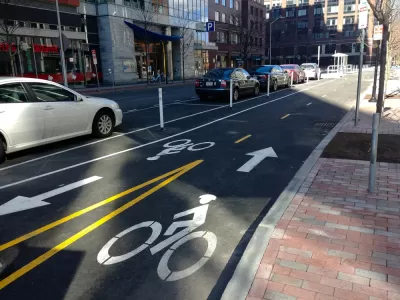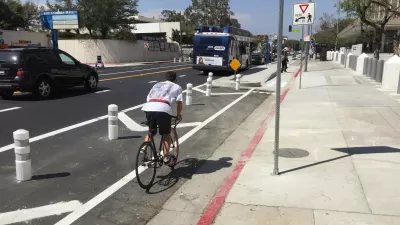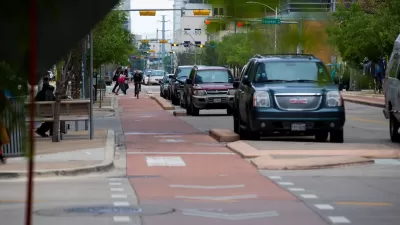The NTSB chair issued a stark warning on Nov. 5: "If we do not improve roadway infrastructure for bicyclists, bicyclists will die who otherwise would not," stated Robert Sumwalt in introducing their first report in 47 years devoted to bike safety.

The National Transportation Safety Board, an independent federal agency charged by Congress with investigating deadly transportation incidents, is alarmed by the increase in deaths of cyclists and pedestrians that have accompanied a reduction in overall traffic fatalities during the last two consecutive years. "Critical changes" are needed, they state in their press release (source article).
The Board met on Nov. 5, 2019, to adopt the findings and recommendations of the Safety Research Report: "Bicyclist safety on US Roadways: Crash Risks and Countermeasures," NTSB’s first analysis of bicyclist safety since 1972. While the final report has yet to be released, readers can view a synopsis [pdf] which contains the executive summary, 23 findings, and 12 recommendations made:
- To the Intelligent Transportation Systems Joint Program Office
- To the National Highway Traffic Safety Administration
- To the Federal Highway Administration
- To the US Consumer Product Safety Commission
- To the 50 states, the District of Columbia, and the Commonwealth of Puerto Rico
- To the American Association of State Highway and Transportation Officials
NTSB staff is currently making final revisions to reflect changes and additions adopted during the Nov. 5 board meeting. Expect the final report in "several weeks" from that date. The synopsis, opening and closing statements, four presentations, and meeting video on YouTube, which includes the presentations, can be accessed at https://go.usa.gov/xpTps.
NTSB focus on the safety of vulnerable road users
"Bicyclists, like pedestrians and motorcyclists, are considered vulnerable road users because they are unprotected by an enclosed vehicle compartment, leaving them more vulnerable to injury or death in the event of a crash," notes the executive summary.
In 2018, the NTSB issued reports addressing pedestrian and motorcyclist safety, and with this safety research report on bicyclist safety, the NTSB again expands its effort to increase awareness of and address safety issues affecting vulnerable road users.
The research focuses on bicycle crashes involving motor vehicles and specifically examines existing and emerging countermeasures designed to improve bicyclist safety on public roads in four areas:
- Roadway and infrastructure designs to separate bicycles from motor vehicle traffic [presentation (pdf)];
- Rider and bicycle conspicuity [visibility] enhancements [presentation (pdf)];
- Vehicle technologies designed to reduce collisions between motorists and bicyclists when they are sharing the road [collision avoidance systems – see conspicuity presentation];
- Protective equipment for reducing the severity of injuries to bicyclists involved in crashes with motor vehicles [bike helmets - presentation (pdf)].
Saving lives
While their recommendations on helmet use may have gathered the most media attention, it is their recommendations for protected bike lanes, which they refer to as separated bike lanes, and other examples of bicycle infrastructure that have the potential to both save lives and increase the popularity of cycling.
Sumwalt made his position quite clear in his compelling opening statement:
Today’s report focuses on how we can prevent collisions between motor vehicles and bicycles by creating an infrastructure that separates bicycles from other traffic. Because preventing a crash from happening in the first place is our top priority...If we do not improve roadway infrastructure for bicyclists, bicyclists will die who otherwise would not.
In the report that we discuss today, we have identified ways that bicycle safety can improve, and the organizations that can make the improvements happen. The question is whether these organizations will act.
Ivan Cheung, an NTSB transportation research analyst, began (at 12:10 in the video) his presentation [pdf] by stating he will "focus on roadway infrastructure safety countermeasures that are effective but underutilized."
Where crashes occur
Bike crashes occur most frequently at street intersections. According to the Federal Highway Administration Course on Bicycle and Pedestrian Transportation [pdf], "41 percent of crashes occurred at roadway intersections, and an additional 8 percent occurred in driveways or alley intersections," although the course data appears dated (1997).
Fatal crashes are another story.
According to the Pedestrian and Bicycle Information Center within the University of North Carolina Highway Safety Research Center, "the majority of pedestrian fatalities (73 percent) and bicyclist fatalities (58 percent) occur at non-intersections."
The most frequent type of fatal collision occurred while a motorist was overtaking a bicyclist in the stretches of roadway between intersections, according to Cheung (see chart in slide 11 in his presentation based on 2014-2016 data, "Improving Roadway Infrastructure for Bicyclists" [pdf]. However, these represented only seven percent of total crashes.
Protected bike lanes as a countermeasure
Referring to slide 13, which shows a one-way, parking-protected bike lane on the right side of the roadway, Cheung states, "Because of the separation, a separated bike lane is expected to eliminate midblock crashes between motor vehicles and bicyclists which tend to produce the most servery injury."
While 35 states reported recommending them, only four had them installed along their state roadways, therefore this effective countermeasure is currently underused.
Readers may recall that California state Senator Scott Weiner (D-San Francisco) introduced legislation this year for urban state highways to be subject to "complete streets" applications, but SB 127 was vetoed on Oct. 12.
His presentation also includes photos and descriptions of one and two-way protected bike lanes, raised and at street level, sometimes referred to as cycle tracks.
Countermeasures recommended at intersections, where most bike crashes occur, include "bicycle signal face," aka bicycle traffic signals, which can reduce intersection crashes up to 45 percent, and two-stage bicycle turn [queue] boxes for left turns, particularly on roads with protected bike lanes on the right side. Since the cyclist essentially waits adjacent to the crosswalk, a pedestrian signal will suffice.
AASHTO call-out
"However, the adoption and implementation [of intersection countermeasures] can be limited by the lack of consolidated geometric design guidance and standards," adds Cheung, which led to a specific recommendation to the American Association of State Highway and Transportation Officials. To their credit, it was noted by AASHTO Journal, their weekly transportation news magazine, in their coverage of the public hearing:
"An effective way to increase adoptions of infrastructure safety measure is to include them in official guidance and standard documents, such as the guide for the development of bicycle facilities which was last published by the American Associations of State Highway and Transportation officials in 2012,” Cheung pointed out in his remarks.
“However, the current edition does not contain information about separated bike lanes and safety treatments of intersection, such as bicycle signal face and two-stage bicycle term box,” he said. “So [NTSB] staff is proposing a recommendation to ensure that bike lanes and intersection treatments are included in the next revision for the [bike] guide.”
According to AASHTO committee staff, revisions to its bike guide are underway. The organization also said that an updated guidebook regarding infrastructure designs for improving pedestrian safety is expected to be published in 2020.
Road diets, where pavement markings are repositioned in order to reduce the number of through lanes and replace them with a center turn lane, are an effective countermeasure for speeding, reducing total crashes by 19% to 47%, according to Cheung. Since 2008, the Federal Highway Administration (FHWA) has included road diets on its list of Proven Safety Countermeasures.
Call-out to FHWA
Another FHWA program that assists state and local transportation agencies with implementing effective countermeasures is Every Day Counts. However, since 2008, no bicyclist safety countermeasures have been added in either program, noted Cheung.
This is inconsistent with the USDOT 2010 policy calling for the improvement of bicycle and pedestrian safety and the full integration of bicycling and walking into the U.S. transportation system. Therefore, staff is proposing a recommendation to the FHWA to include separated bicycle lanes and intersection safety treatments in the Proven Safety Countermeasures initiative and the Every Day Counts program.
A Planetizen post shows that in May 2015, FHWA announced new guidelines for the planning and design of separated bike lanes.
A timely reminder from FHWA
While FHWA may be lagging in their bike and pedestrian programs, they deserve credit in their Bicycle and Pedestrian Coursebook [pdf] for distinguishing between crashes and accidents:
The word “crash” may be new to some people as a way to describe the event in which a bicyclist or pedestrian greets the ground, a motor vehicle, or any other solid object in a way that can result in bodily harm and/or property damage. Historically, these were called “accidents.” The term “accident” implies heavy doses of chance, unknown causes, and the connotation that nothing can be done to prevent them.
While the NTSB continues to use the word "accident," the researchers in this safety report use the words "crash" and "collision."
Media coverage of NTSB report:
-
Smart Cities Dive: NTSB recommends mandatory helmet laws, protected bike lanes, Nov. 6, 2019
-
Sacramento Bee: Biggest reason for fatal cycling crashes? Drivers overtaking bikes, Nov. 5, 2019
-
AASHTO Journal: NTSB Hearing Seeks Bicycle, Pedestrian Safety Improvement, Nov. 8, 2019
- Bicycling: The Actual Reasons More Cyclists Are Dying on the Streets, Nov. 13, 2019
Additional resources:
- NHTSA: Traffic Safety Facts: 2018 Fatal Motor Vehicle Crashes: Overview [pdf], October 2019
- NHTSA: Traffic Safety Facts: Bicyclists and Other Cyclists [pdf], May 2018
Related in Planetizen:
-
Panel Recommends Federal Bike Helmet Law, November 6, 2019
-
Governor's Veto Kills Complete Streets Requirements for Caltrans, October 14, 2019
-
Less Paint, More Barriers, Make for Better Urban Cycling [academic research], June 3, 2019
-
NACTO Guide Aids Bike Safety in the Intersection, May 22, 2019
-
Hit-and-Run Traffic Fatalities Reach Record High (countermeasures explored), April 30, 2018
-
Study: High-Visibility Clothing No Solution for Bike Safety, April 18, 2018
-
NTSB Investigates Horrific Bicycle Crashes Too, August 18, 2016
-
How to Navigate Night Cycling, July 29, 2013

Alabama: Trump Terminates Settlements for Black Communities Harmed By Raw Sewage
Trump deemed the landmark civil rights agreement “illegal DEI and environmental justice policy.”

Planetizen Federal Action Tracker
A weekly monitor of how Trump’s orders and actions are impacting planners and planning in America.

The 120 Year Old Tiny Home Villages That Sheltered San Francisco’s Earthquake Refugees
More than a century ago, San Francisco mobilized to house thousands of residents displaced by the 1906 earthquake. Could their strategy offer a model for the present?

LA’s Tree Emergency Goes Beyond Vandalism
After a vandal destroyed dozens of downtown LA trees, Mayor Karen Bass vowed to replace them. Days later, she slashed the city’s tree budget.

Sacramento Leads Nation With Bus-Mounted Bike Lane Enforcement Cameras
The city is the first to use its bus-mounted traffic enforcement system to cite drivers who park or drive in bike lanes.

Seattle Voters Approve Social Housing Referendum
Voters approved a corporate tax to fund the city’s housing authority despite an opposition campaign funded by Amazon and Microsoft.
Urban Design for Planners 1: Software Tools
This six-course series explores essential urban design concepts using open source software and equips planners with the tools they need to participate fully in the urban design process.
Planning for Universal Design
Learn the tools for implementing Universal Design in planning regulations.
Ada County Highway District
Clanton & Associates, Inc.
Jessamine County Fiscal Court
Institute for Housing and Urban Development Studies (IHS)
City of Grandview
Harvard GSD Executive Education
Toledo-Lucas County Plan Commissions
Salt Lake City
NYU Wagner Graduate School of Public Service




























